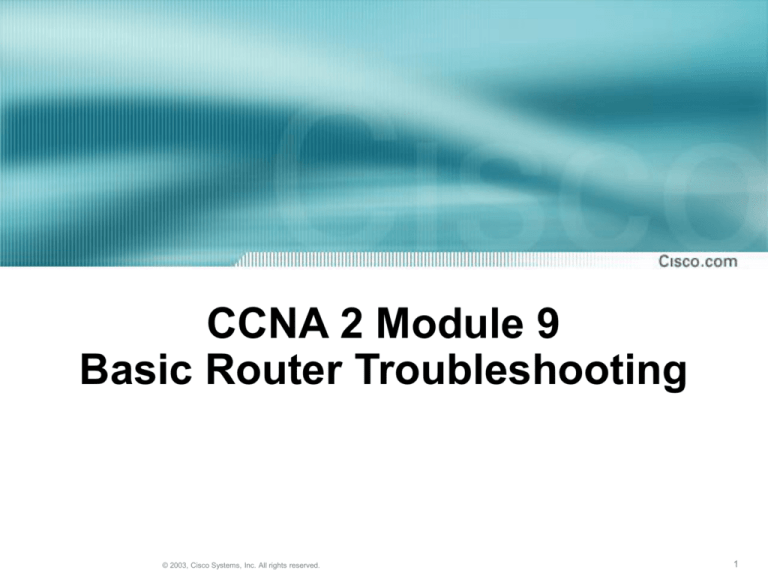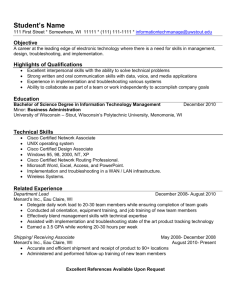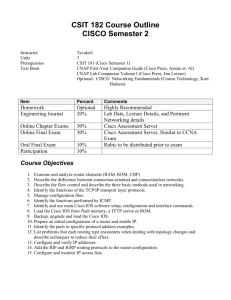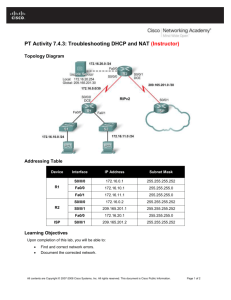
CCNA 2 Module 9
Basic Router Troubleshooting
© 2003, Cisco Systems, Inc. All rights reserved.
1
Objectives
• Examining the routing table
• Network testing
• Troubleshooting router issues
© 2003, Cisco Systems, Inc. All rights reserved.
2
The show ip route Command
The show ip route command displays the
contents of the IP routing table.
© 2003, Cisco Systems, Inc. All rights reserved.
3
Static Routing
© 2003, Cisco Systems, Inc. All rights reserved.
4
Dynamic Routing
© 2003, Cisco Systems, Inc. All rights reserved.
5
Default Route
© 2003, Cisco Systems, Inc. All rights reserved.
6
Default Route
Continued
© 2003, Cisco Systems, Inc. All rights reserved.
7
Configuring a Default Route
• The ip default-network command
establishes a default route in networks
using dynamic routing protocols.
Router(config-router)#ip
default-network network-number
• Creating an ip route to 0.0.0.0/0 is
another way to configure a default route.
Router(config)#ip route 0.0.0.0
0.0.0.0 [next-hop-ip-address |
exit-interface]
© 2003, Cisco Systems, Inc. All rights reserved.
8
Determining Route Source and
Destination
© 2003, Cisco Systems, Inc. All rights reserved.
9
Determining L2 and L3 Addresses
© 2003, Cisco Systems, Inc. All rights reserved.
10
Determining Administrative Distance
© 2003, Cisco Systems, Inc. All rights reserved.
11
Determining the Route Metric
Routing protocols use metrics to
determine the best route to a destination.
© 2003, Cisco Systems, Inc. All rights reserved.
12
Determining the Route Metric
Continued
Factors such as bandwidth and
delay are static because they
remain the same for each
interface until the router is
reconfigured or the network is
redesigned. Factors such as
load and reliability are
dynamic because they are
calculated for each interface in
real-time by the router
© 2003, Cisco Systems, Inc. All rights reserved.
13
Determining the Route Next Hop
• Destination/next hop associations tell a
router that a particular destination can be
reached optimally by sending the packet
to a particular router.
© 2003, Cisco Systems, Inc. All rights reserved.
14
Determining the Last Routing Update
• Use the following commands to find the
last routing update:
show ip route
show ip route network
show ip protocols
show ip rip database
© 2003, Cisco Systems, Inc. All rights reserved.
15
The show ip route Command
© 2003, Cisco Systems, Inc. All rights reserved.
16
The show ip route network
Command
© 2003, Cisco Systems, Inc. All rights reserved.
17
The show ip protocols Command
© 2003, Cisco Systems, Inc. All rights reserved.
18
The show ip rip database
Command
© 2003, Cisco Systems, Inc. All rights reserved.
19
Observing Multiple Paths to a
Destination
• Some routing protocols support multiple
paths to the same destination.
• Unlike single path algorithms, these multipath algorithms permit traffic over multiple
lines, provide better throughput, and are
more reliable.
© 2003, Cisco Systems, Inc. All rights reserved.
20
Introduction to Network Testing
© 2003, Cisco Systems, Inc. All rights reserved.
21
Structured Approach to
Troubleshooting
© 2003, Cisco Systems, Inc. All rights reserved.
22
Typical Layer 1 Errors
• Broken cables
• Disconnected cables
• Cables connected to the
wrong ports
• Intermittent cable connection
• Wrong cables used for the
task at hand
• Transceiver problems
• DCE cable problems
• DTE cable problems
• Devices turned off
© 2003, Cisco Systems, Inc. All rights reserved.
23
Typical Layer 2 Errors
• Improperly configured serial
interfaces
• Improperly configured
Ethernet interfaces
• Improper encapsulation set
• Improper clock rate settings
on serial interfaces
• Network interface card (NIC)
problems
© 2003, Cisco Systems, Inc. All rights reserved.
24
Typical Layer 3 Errors
• Routing protocol not enabled
• Wrong routing protocol
enabled
• Incorrect IP addresses
• Incorrect subnet masks
© 2003, Cisco Systems, Inc. All rights reserved.
25
Layer 1 Problems in a Network
© 2003, Cisco Systems, Inc. All rights reserved.
26
Layer 7 Troubleshooting
Using Telnet
© 2003, Cisco Systems, Inc. All rights reserved.
27
Troubleshooting Layer 1
Using link light
• Most interfaces or NICs have indicator light that show whether
there is a valid connection.
• This light is referred to as the link light.
• A faulty or incorrect cable could result in a link light indicating a
bad connection or no link
• If the interface has indicator light that do not show a valid
connection, power off the device and reset the interface card
• Check to make sure that all cables are connected to the ports.
• Make sure that proper cable is being used.
• Before running diagnostics or attempt trobleshooting, always
check to make sure that the device is powered on.
© 2003, Cisco Systems, Inc. All rights reserved.
28
Troubleshooting Layer 1
Using show interfaces Command
The show interfaces serial command
The show interfaces serial command
output are displayed as the line (Layer 1)and
data-link protocol (Layer 2) status.
© 2003, Cisco Systems, Inc. All rights reserved.
29
Troubleshooting Layer 1
Using show interfaces Command
• The second parameter (protocol) indicates whether the line
protocol consider the interface usable.
• This is determined by whether keepalives are successfully
received. Keepalives are defined as messages sent by one
network device to inform another network device that the
virtual circuit between the two is still active. If the interface
misses three consecutive keepalives, the line protocol is
marked as down.
• If the interface is up and the line protocol is down, a Layer 2
problem exists. Among the possible causes are:
• No keepalives
• No clock rate
• Mismatch in encapsulation type
© 2003, Cisco Systems, Inc. All rights reserved.
30
Troubleshooting Layer 1
Using show interfaces Command - Continued
The show interfaces serial command
© 2003, Cisco Systems, Inc. All rights reserved.
31
Troubleshooting Layer 1
Using show interfaces Command - Continued
• An increasing number of carrier transitions
counts on a serial link may indicate one or
more of the following problems:
• Line interruptions due to problems in the
service provider network.
• Faulty switch, DSU, or router hardware.
© 2003, Cisco Systems, Inc. All rights reserved.
32
Troubleshooting Layer 1
Using show interfaces Command - Continued
• If an increasing number of input errors appear, there
are several possible sources of those errors. Some
of these related to Layer 1 problems are:
• Faulty telephone company equipment
• Noisy serial line
• Incorrect cable or cable length
• Damaged cable or connection
• Defective CSU or DSU
• Defective router hardware
© 2003, Cisco Systems, Inc. All rights reserved.
33
Troubleshooting Layer 1
Using show interfaces Command - Continued
• Another area to examine is number of interface
resets. These are the result of too many missed
keepalives. The following Layer 1 problems could
be a cause of interface resets:
• Bad line causing carrier transitions
• Possible hardware problem at the CSU, DSU, or
switch
• If carrier transitions and interface resets are
increasing or if input errors are high while interface
resets are increasing, the problem is likely to be a
bad link or defective CSU or DSU
© 2003, Cisco Systems, Inc. All rights reserved.
34
Troubleshooting Layer 2
Using show interfaces Command
© 2003, Cisco Systems, Inc. All rights reserved.
35
Troubleshooting Using show cdp
neighbors Command
If the physical layer is properly functioning, then all other
directly connected Cisco devices should be displayed. If no
known device appears, a Layer 1 problem likely exists.
© 2003, Cisco Systems, Inc. All rights reserved.
36
Troubleshooting Using show cdp
neighbors detail Command
© 2003, Cisco Systems, Inc. All rights reserved.
37
Troubleshooting Layer 3
Using Ping
© 2003, Cisco Systems, Inc. All rights reserved.
38
Troubleshooting Layer 3
Using traceroute Command
Traceroute also provides information indicating the
relative performance of links: the round trip time (RTT) is
the time required to send an echo packet and get a
response. If an asterisk (*) appears, the packet failed.
© 2003, Cisco Systems, Inc. All rights reserved.
39
The traceroute Operation
• The followings are the traceroute operation:
• Traceroute sends out a sequence of User Datagram Protocol (UDP)
datagrams from the router to an invalid port address on the remote
host.
• For the first sequence of three datagrams sent, a Time-To-Live (TTL)
field value is set to one. The TTL value of 1 causes the datagram to
time out at the first router in the path. This router then responds with an
ICMP Time Exceeded Message (TEM) indicating that the datagram
has expired.
• Three more UDP messages are now sent, this time with the TTL value
set to 2. This causes the second router to return ICMP TEMs.
• This process continues until the packets actually reach the other
destination.
• Since these datagrams are trying to access an invalid port at the
destination host, ICMP Port Unreachable Messages are returned
instead of the ICMP Time Exceeded Message. This indicates an
unreachable port and signals the traceroute program, terminating the
process.
40
© 2003, Cisco Systems, Inc. All rights reserved.
Troubleshooting Routing Issues
The show ip route Command
If the output of the show
ip route command
does not show the
expected learned routes
or no learned routes,
then the problem is
possibly that routing
information is not being
exchanged. In this case,
use the show ip
protocols command
on the router to check
for a routing protocol
configuration error.
© 2003, Cisco Systems, Inc. All rights reserved.
41
Troubleshooting Routing Issues
The show ip protocols Command
© 2003, Cisco Systems, Inc. All rights reserved.
42
Troubleshooting Using show
controllers serial Command
The show controllers serial Command
By examining the
show controllers
serial command
output, the type of
cable that the
controller detects can
be determined. This is
useful for finding a
serial interface with
no cable, the wrong
type of cable, or a
defective cable.
© 2003, Cisco Systems, Inc. All rights reserved.
43
Introduction to debug
Debug syntax
© 2003, Cisco Systems, Inc. All rights reserved.
44
Summary
© 2003, Cisco Systems, Inc. All rights reserved.
45







